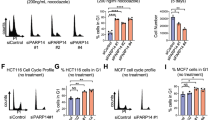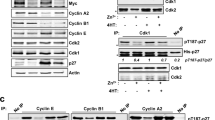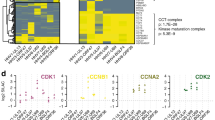Abstract
Cyclin G was previously identified as a target gene of the p53 tumor suppresser protein, and levels of cyclin G are increased after induction of p53 by DNA damage. However, the function of cyclin G has not been established. To determine the effect of increased expression of cyclin G, retroviruses encoding cyclin G were constructed and used to infect three different murine cell lines. Cyclin G protein levels induced by the retroviruses were within the range seen after DNA damage induction of p53. In each case we observed that such over-expression of cyclin G augments the apoptotic process. TNF-α induction of apoptosis is increased by expression of cyclin G in NIH3T3 fibroblasts which express p53, as well as in 10.1 fibroblasts which contain no p53 allele. Additionally, we observed that while cyclin G expression is markedly reduced upon aggregate formation in embryonic carcinoma P19 cells, retrovirus-mediated over-expression of cyclin G enhances apoptotic cell death in aggregated P19 cells, and increases the extent of apoptosis caused by retinoic acid or serum starvation of these cells. These data demonstrate that cyclin G plays a facilitating role in modulating apoptosis induced by different stimuli. Moreover, we have discovered that cyclin G expression is rapidly induced in P19 cells after exposure to Bone Morphogenic Protein-4 (BMP-4), suggesting that cyclin G may mediate apoptotic signals generated by BMP-4.
This is a preview of subscription content, access via your institution
Access options
Subscribe to this journal
Receive 50 print issues and online access
$259.00 per year
only $5.18 per issue
Buy this article
- Purchase on Springer Link
- Instant access to full article PDF
Prices may be subject to local taxes which are calculated during checkout





Similar content being viewed by others
References
Adams JM and Cory S. . 1998 Science 281: 1322–1326.
Almog N and Rotter V. . 1997 Biochim. Biophys. Acta. 1333: 1–27.
Ashkenazi A and Dixit VM. . 1998 Science 281: 1305–1308.
Bates S, Rowan S and Vousden KH. . 1996 Oncogene 13: 1103–1109.
Beyaert R and Fiers W. . 1994 FEBS Lett. 340: 9–16.
Buckbinder L, Talbott R, Velasco-Miguel S, Takenaka I, Faha B, Seizinger BR and Kley N. . 1995 Nature 377: 646–649.
Chen MJ, Holskin B, Strickler J, Gorniak J, Clark MA, Johnson PJ, Mitcho M and Shalloway D. . 1987 Nature 330: 581–583.
Evan GI, Wyllie AH, Gilbert CS, Littlewood TD, Land H, Brooks M, Waters CM, Penn LZ and Hancock DC. . 1992 Cell 69: 119–128.
Gavrieli Y, Sherman Y and Ben-Sasson SA. . 1992 J. Cell Biol. 119: 493–501.
Gjertsen BT and Doskeland SO. . 1995 Biochim. Biophys. Acta. 1269: 187–199.
Glozak MA and Rogers MB. . 1996 Dev. Biol. 179: 458–470.
Gottlieb TM and Oren M. . 1996 Biochim. Biophys. Acta. 1287: 77–102.
Graham A, Francis-West P, Brickell P and Lumsen A. . 1994 Nature 372: 684–686.
Harvey DM and Levine AJ. . 1991 Genes Dev. 5: 2375–2385.
Heichman KA and Roberts JM. . 1994 Cell 79: 557–562.
Hollstein M, Rice K, Greenblatt MS, Soussi T, Fuchs R, Sorlie T, Hovig E, Smith-Sorensen B, Montesano R and Harris CC . . (1994 Nucleic Acids Res 22: 3551–3555.
Horne MC, Goolsby GL, Donaldson KL, Tran D, Neubauer M and Wahl AF. . 1996 J. Biol. Chem. 271: 6050–6061.
Sorensen B, Montesano R and Harris CC. . 1994 Nucl. Acids Res. 22: 3551–3555.
Janicke RU, Lee FH and Porter AG. . 1994 Mol. Cell. Biol. 14: 5661–5670.
Janicke RU, Lin XY, Lee FH and Porter AG. . 1996 Mol. Cell. Biol. 16: 5245–5253.
Jensen RJ, Factor VM and Thorgeirsson SS. . 1998 Hepatology 28: 537–546.
Kanaoka Y, Kimura SH, Okazaki I, Ikeda M and Nojima H. . 1997 FEBS lett. 402: 73–80.
Kingsley DM. . 1994 Genes Dev. 8: 133–146.
Klefstrom J, Vastrik I, Saksela E, Valle J, Eilers M and Alitalo K. . 1994 EMBO J. 13: 5442–5450.
Ko LJ and Prives C. . 1996 Genes Dev. 10: 1054–1072.
Levine AJ. . 1993 Ann. Rev. Biochem. 62: 623–651.
Lowe SW and Ruley HE. . 1993 Genes Dev. 7: 535–545.
McCurrach ME, Conner TMF, Knudson CM, Korsmeyer SJ and Lowe SW. . 1997 Proc. Natl. Acad. Sci. USA 94: 2345–2349.
Miyashita T and Reed JC. . 1995 Cell 80: 293–299.
Ninomiya Y, Adams R, Morris-Kay GM and Ito K. . 1997 J. Cell. Physiol. 172: 25–35.
Okamoto K and Beach D. . 1994 EMBO J. 13: 4816–4822.
Okamoto K, Kamibayashi C, Serrano M, Prives C, Mumby MC and Beach D. . 1996 Mol. Cell. Biol. 16: 6593–6602.
Pear WS, Nolan GP, Scott ML and Baltimore D. . 1993 Proc. Natl. Acad. Sci. USA 90: 8392–8396.
Raff MC. . 1992 Nature 356: 397–400.
Reed JC. . 1997 Adv. Pharmacol. 41: 501–532.
Robbins PB, Yu XJ, Skelton DM, Pepper KA, Wasserman RM, Zhu L and Kohn DB. . 1997 J. Virol. 71: 9466–9474.
Rudnicki MA and McBurney MW. . 1987 Teratocarcinomas and embryonic stem cells: A practical approach. Robertson EJ. (ed.).. IRL Press: Washington DC pp. 19–49.
Sherr CJ. . 1994 Cell 79: 551–555.
Smith ML, Konty HU, Bortnick R and Fornace AJJ. . 1997 Exp. Cell Res. 230: 61–68.
Sofer-Levi Y and Resnitzky D. . 1996 Oncogene 13: 2431–2437.
Tamura K, Kanaoka Y, Jinno S, Nagata A, Ogiso Y, Shimizu K, Hayakawa T, Nogima H and Okayama H. . 1993 Oncogene 8: 2113–2118.
Thompson CB. . 1995 Science 267: 1456–1462.
Vermes I, Haanen C, Steffens-Nakken H and Reutelingsperger C. . 1995 J. Immunol. Methods 184: 39–51.
Vogelstein B and Kinzler KW. . 1992 Cell 70: 523–526.
White DW, Roy A and Gilmore TD. . 1995 Oncogene 10: 857–868.
Wyllie AH, Kerr JF and Currie AR. . 1980 Int. Rev. Cytol. 68: 251–306.
Zauberman A, Lupo A and Oren M. . 1995 Oncogene 10: 2361–2366.
Acknowledgements
We thank Paul B Robbins for the retrovirus vector, Jill Bargonetti for 10.1 cells, and Ella Freulich for technical support. BMP-4 was a generous gift from Genetics Institute. These studies were supported by NIH grant CA58316.
Author information
Authors and Affiliations
Rights and permissions
About this article
Cite this article
Okamoto, K., Prives, C. A role of cyclin G in the process of apoptosis. Oncogene 18, 4606–4615 (1999). https://doi.org/10.1038/sj.onc.1202821
Received:
Revised:
Accepted:
Published:
Issue Date:
DOI: https://doi.org/10.1038/sj.onc.1202821
Keywords
This article is cited by
-
Single-cell transcriptomic analysis identifies the conversion of zebrafish Etv2-deficient vascular progenitors into skeletal muscle
Nature Communications (2020)
-
Atypical cyclins: the extended family portrait
Cellular and Molecular Life Sciences (2020)
-
MiR-23b targets cyclin G1 and suppresses ovarian cancer tumorigenesis and progression
Journal of Experimental & Clinical Cancer Research (2016)
-
Comprehensive phenotypic analysis of knockout mice deficient in cyclin G1 and cyclin G2
Scientific Reports (2016)
-
ELAS1-mediated inhibition of the cyclin G1–B'γ interaction promotes cancer cell apoptosis via stabilization and activation of p53
Oncogene (2015)



